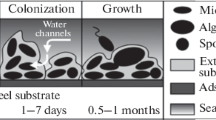Abstract
Because this paper marks 50 years since the first Mattiello Memorial Lecture, it begins with a remembrance of the man in whose honor we meet and an appreciation of his character and his contributions to the coatings industry. The body of the paper is concerned with the coating used on a hull of a ship to prevent the accumulation of barnacles and other fouling. The most effective antifouling paint now being used contains toxins and will be forbidden by international regulations within eight years. The ideal replacement will be a nontoxic material that resists the attachment of marine life and encourages the organisms to fall off the ship. This paper describes laboratory and field work during the past 18 years on a variety of fluorinated coatings and silicone coatings with these properties and criteria for formulating successful nontoxic coatings. Silicone and fluorinated coatings frustrate fouling by different mechanisms, and thus the criteria for a successful coating are distinct in important ways.
Similar content being viewed by others
References
Kienle, R.H., “Physical Chemical Research in the Protective Coatings Industry,”Official Digest,22, No. 300, 11–51 (1950).
Schulenberg, F., “Lest We Forget,”Am. Paint & Coat. J. Convention Daily, November 8, 1989, p. 7.
Greco, W. J., “The History of the NYSCT,” an address to the New York Society for Coatings Technology on its 50th Anniversary, April 1, 1969; available at http://nysct.org/history2.htm.
Schulenberg, F., “The Gallows Birds,”Am. Paint & Coat. J. Convention Daily, November 8, 1989, p. 8, 41.
Payne, H.F., “Philosophy of Coatings,”Official Digest,32, No. 430, 1371–1434 (1960).
Callow, M., “Ship Fouling: Problems and Solutions,”Chem. & Ind., 123–27 (1990).
Pain, S., “How to Rule the Waves,”New Scientist, 162, No. 2191, 54–55 (June 19, 1999).
IMO News, The Magazine of the International Maritime Organization, 43 Albert Embarkment, London SE1 7SR, United Kingdom, Number 4, pp. 8–10 (1998).
Naldrett, M.J., “The Importance of Sulphur Crosslinks and Hydrophobic Interactions in the Polymerization of Barnacle Cement,”J. Mar. Biol. Assn. U.K., 73, 689–702 (1993).
Waite, J.H., “Evidence for a Repeating 3,4-Dihydroxyphenylalanine-and Hydroxyproline-Containing Decapeptide in the Adhesive Protein of the Mussel,Mytilus edulis L.,”J. Biol. Chem., 258, 2911–15 (1983)
Waite, J.H., “The Formation of Mussel Byssus,” in Case, S.T. (Ed.),Results and Problems in Cell Differentiation, Springer-Verlag, Berlin, Vol 2, pp. 27–54, 1992
Papov, V.V., Diamond, T.V., Biemann, K., and Waite, J.H., “Hydroxyarginine-Containing Polyphenolic Proteins in the Adhesive Plaques of the Marine MusselMytilus edulis,”J. Biol. Chem., 270, 20183–92 (1995).
Brady, Jr., R.F., “In Search of Nonstick Coatings,”Chem. & Ind., 219–22 (1997).
Brady, R.F. Jr., “Fluorinated Polyurethane Coatings for Unique Defense Applications,”Eur. Coat. J., 31, 267–69 (1995).
Brady, R.F., Jr., “Coming to an Unsticky End,”Nature, 368, No. 6466, 16–17 (1994).
Griffith, J.R. and Brady, R.F., Jr., “Ready for the Market: An Intriguing Class of Coatings,”Chemtech, 19, 370–373 (1989).
Brady, R.F., Jr., Griffith, J.R., Love, K.S., and Field, D.E., “Nontoxic Alternatives to Antifouling Paints,”Journal of Coatings Technology,59, No. 755, 113–19 (1987).
Zisman, W.A., “Surface Energetics of Wetting, Spreading, and Adhesion,”Journal of Coatings Technology,44, No. 564, 41–57 (1972).
O’Rear, J.G., Griffith, J.R., and Reines, S.A., “Some New Fluorinated Epoxies and Polymeric Derivatives,”Journal of Paint Technology,43, No. 552, 113 (1971)
Reines, S.A., Griffith, J.R., and O’Rear, J.G., “Substitutent Effects in the Reaction Rates of 2-Arylhexafluoroisopropyl Glycidyl Ethers with Dibutylamine,”J. Org. Chem., 36, 1209–13 (1971)
Griffith, J. R., O’Rear, J. G., and Reines, S. A., “Fluorinated Epoxy Resins,”Chemtech, 311–16 (1972)
Reardon, J.P., O’Rear, J.G., and Griffith, J.R., “Preparation and Wetting Characteristics of Some Poly(Fluorinated Aromatic Glycidyl Ethers),”Ind. Eng. Chem. Prod. Res. & Dev., 11, 365 (1972)
Griffith, J.R. and O’Rear, J.G., “3,3-Bis(Trifluoromethyl)Oxiranes,”Ind. Eng. Chem. Prod. Res. & Dev., 13, 148 (1974)
Griffith, J.R. and O’Rear, J.G., “Synthesis of 1,3-Bis[2-Hydroxyhexafluoro-2-Propyl]-5-Perfluoroalkyl Benzenes,”Synthesis, 7, 493 (1974).
O’Rear, J.G. and Griffith, J.R. (to the Secretary of the Navy), “Bis(Trifluoromethyl) Epoxides,” U.S. Patent 3,849,450 (November 19, 1974)
O’Rear, J.G. and Griffith, J.R. (to the Secretary of the Navy), “Highly Fluorinated Diglycidyl Ethers,” U.S. Patent 3,993,631 (July 9, 1975)
O’Rear, J.G. and Griffith, J.R. (to the Secretary of the Navy), “Fluoroanhydride Curing Agents and Precursors Thereof for Fluorinated Epoxy Resins,” U.S. Patent 4,045,408 (August 30, 1977)
Griffith. J.R. and O’Rear, J.G. (to the Secretary of the Navy), “Cis-Trans Fluoropolyol Polyacrylate,” U.S. Patent 4, 284,747 (August 18, 1981).
Field, D.E. and Griffith, J.R., “Cross-Linked Fluoropolymer Coatings,”Ind. Eng. Chem. Prod. Res. & Dev, 14, 52–54 (1975)
Field, D.E., “Fluorinated Polyepoxy and Polyurethane Coatings,”Journal of Coatings Technology,48, No. 615, 43–7 (1976)
Field, D.E. and Griffith, J.R. (to the Secretary of the Navy), “Fluorinated Network Polymers,” U.S. Patent 4,157,358, June 5, 1979.
Bultman, J.D. and Griffith, J.R., “Fluorinated Naval Coatings,”Ind. Eng. Chem. Prod. Res. & Dev., 17, 8–9 (1978)
Griffith, J.R. and Bultman, J.D., “Fouling Release Coatings,”Naval Engineers J., 92, 129–132 (1980).
Moniz, W.B., Griffith, J.R., Brady, Jr., R.F., and Thompson, C.M., “Fluorinated Organic Polymers for Diverse Applications,”NRL Memorandum Report 5517, March 6, 1985.
21st Century Coatings, Inc., 1439 N. Great Neck Road, Virginia Beach, VA 23454; 757-496-9008; fax 757-496-9050.
Brady, R.F., Jr., “Formulations and Field Performance of Fluorinated Polyurethane Coatings,” inOrganic Coatings for Corrosion Control, Bierwagen, G. P. (Ed.), ACS Symposium Series 689, American Chemical Society, Washington, D.C., Chap. 22, pp. 282–91, 1998.
Bonafede, S.J. and Brady, R.F., Jr., “Compositional Effects on the Fouling Resistance of Fluorourethane Coatings,”Sur. Coat. Int., 81 (4), 181–185 (1998).
Moore, G., Zhu, D.-W., Clark, G., Pellerite, M., Burton, C., Schmidt, D.L., and Coburn, C.E., “Water-Borne Crosslinkable Fluorochemical Coatings,Sur. Coat. Int., 79, 377 (1995)
Schmidt, D.L., DeKoven, B.M., Coburn, C.E., Potter, G.E., Meyers, G.F., and Fisher, D.A., “Characterization of a New Family of Non-Wettable, Non-Stick Surfaces,”Langmuir, 12, 518 (1996)
Lin, J., Zhu, J., Swanson, D.R., and Milco, L., “Cross-Linking and Physical Characteristics of a Water-Based Nonstick Hydrophobic Coating,”Langmuir, 12, 6676–80 (1996).
Brady, Jr., R.F., Bonafede, S.J., and Schmidt, D.L., “Self-Assembled Waterborne Fluoropolymer Coatings for Marine Fouling Resistance,”Sur. Coat. Int., in press (1999).
Saroyan, J.R., Lindler, E., Dooley, C.A., and Bleile, H.R., “Barnacle Cement—Key to Second-Generation Antifouling Coatings,”Ind. Eng. Chem. Prod. Res. & Dev., 9, 123–28 (1970).
Bonafede, S.J., Pawlikowski, G.T., and Brady, R.F., Jr., “Macrofouling of Hydrocarbon Polymers which Contain Variable Proportions of Crystallinity,”Biofouling, 14, 1–14 (1999).
Brady, Jr., R.F. and Pawlikowski, G.T. (to the Secretary of the Navy), “Robust Nontoxic Antifouling Polymers,” U.S. Patent 5,652,027 (July 29, 1997).
Anon., “Surface Preparation Specification No. 10, Near-White Blast Cleaning,”Steel Structures Painting Manual, Keane, J.D. (Ed.), Steel Structures Painting Council, Pittsburgh, Vol. 2, pp. 47–48, 1982.
Bullock, S., Johnston, E.E., Wilson, T., Gatenholm, P., and Wynne, K.J., “Surface Science of a Filled Polydimethylsiloxane-Based Alkoxysilane-Cured Elastomer: RTV-11,”J. Colloid Interfac. Sci., 210, 18–36 (1999).
Adkins, J.D., Mera, A.E., Roe-Short, M.A., Pawlikowski, G.T., and Brady, R.F., Jr., “Novel Nontoxic Coatings Designed to Resist Marine Fouling,”Prog. Org. Coat., 29, 1–5 (1996).
Brady, Jr., R.F. and Adkins, J.D., “Antifouling and Nonfouling Coatings for Sonar Dome Rubber Windows (SDRWs) and Sonar Rubber Domes (SRDs); Progress Report,” NRL Letter Report 6120–260, August 30, 1993.
Lewis, J.A., Foster, T., and Brady, Jr., R.F., “Environmentally Acceptable Flexible Fouling Release or Prevention Coatings,”Final Report, TTCP MAT Group Assignment MAT-TP-6-O9, June 1997.
Jones-Meehan, J., Cella, J., Montemarano, J.A., Swain, G.W., Wiebe, D., Meyer, A. and Baier, R.E., “Advanced Nontoxic Fouling Release Coatings,” Naval Research Laboratory Report NRL/PU/6110-99-388, July 27, 1999.
Milne, A. and Callow, M.E., “Non-Biocidal Antifouling Processes,” in Smith, R. (Ed.), “Polymers in a Marine Environment,” London,Trans. Inst. Marine Eng. (C), 97, Conference 2, Paper 37, 229–33 (1985).
Milne, A. (to The International Paint Company, Ltd.), “Anti-Fouling Marine Compositions,” U.S. Patent 4,025,693 (May 24, 1977)
McLearie, J., Finnie, A.A., Andrews, A.F., Millichamp, I.S., and Milne, A. (to The International Paint Company, Ltd.), “Anti-Fouling Coating Compositions,” U.S. Patent 5,302,192 (April 12, 1994).
Ghanem, N.A., El-Awady, N.I., El-Hamouly, W.S. and El-Awady, M.M., “New Approaches to Non-Toxic Antifouling Coatings for Ship-Hull Protection,”Journal of Coatings Technology,54, No. 684, 83–88 (1982).
Griffith, A.A., “The Phenomena of Rupture and Flow in Solids,”Philosophical Transactions of the Royal Society (London), A221, 163–198 (1921).
Kinloch, A.J. and Young, R.J.,Fracture Behaviour of Polymers, Applied Science Publishers, London, 1983.
Kendall, K., “The Adhesion and Surface Energy of Elastic Solids,”J. Physics D: Appl. Phys., 4, 1186–1195 (1971).
Brady, Jr., R.F. and Singer, I.L., “Mechanical Factors Favoring Release from Fouling Release Coatings,”Biofouling, in press (1999).
Zisman, W.A., “Relation of the Equilibrium Contact Angle to Liquid and Solid Constitution,” in Gould, R.F. (Ed.),Contact Angle: Wettability and Adhesion, American Chemical Society, Washington, D.C.,Adv. Chem. Ser. 43, pp. 1–51 (1964).
Baier, R.E. and DePalma, V.A., “The Relation of the Internal Surface of Grafts to Thrombosis,” in Dale, W.A. (Ed.),Management of Occlusive Arterial Disease, Yearbook Medical Publishers, Chicago, pp. 147–163, 1971.
Brady, R.F., Jr., “Properties Which Influence Marine Fouling Resistance in Polymers Containing Silicon and Fluorine.”Prog. Org. Coat., 35, 31–35 (1999).
Roland, C.M. and Ngai, K.L., “Segmental Relaxation in Poly(dimethylsiloxane),”Macromolecules, 29, 5747–50 (1996).
Zhang Newby, B.-M., Chaudhury, M.K., and Brown, H.R., “Macroscopic Evidence of the Effect of Interfacial Slippage on Adhesion,”Science, 269, 1407–1409 (1995)
Zhang Newby, B.-M. and Chaudhury, M.K., “Effect of Interfacial Slippage on Viscoelastic Adhesion,”Langmuir, 13, 1805–1809 (1997).
Brady, R.F., Jr., “Fluoropolymers,”Chemistry in Britain, 26, 427–430 (1990).
Kohl, J.G. and Singer, I.L., “Pull-Off Behavior of Epoxy Bonded to Silicone Duplex Coatings,”Prog. Org. Coat., 36, 15–20 (1999).
Swain, G.W., Schultz, M.P., Griffith, J.R. and Snyder, S., “The Relationship Between Barnacle and Pseudo-Barnacle Adhesion Measurements: A Method to Predict the Foul Release Properties of Silicones,” in Brady, R.F. Jr., and Park, Y. (Eds.),Proceedings, Workshop on Emerging Nonmetallic Materials for the Marine Environment, Office of Naval Research, Arlington, pp. 1–60 to 1–69 (1997).
Swain, G.W., Griffith, J.R., Bultman, J.D., and Vincent, H.L., “The Use of Barnacle Adhesion Measurements for the Field Evaluation of Non-Toxic Foul Release Surfaces,”Biofouling, 6, 105–114 (1992).
Author information
Authors and Affiliations
Additional information
Chemistry Div., Washington, D.C. 20375-5342.
Rights and permissions
About this article
Cite this article
Brady, R.F. Clean hulls without poisons: Devising and testing nontoxic marine coatings. Journal of Coatings Technology 72, 45–56 (2000). https://doi.org/10.1007/BF02698394
Issue Date:
DOI: https://doi.org/10.1007/BF02698394




